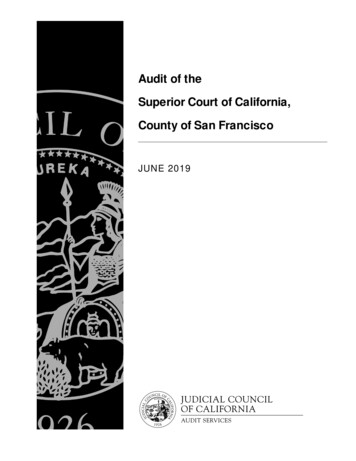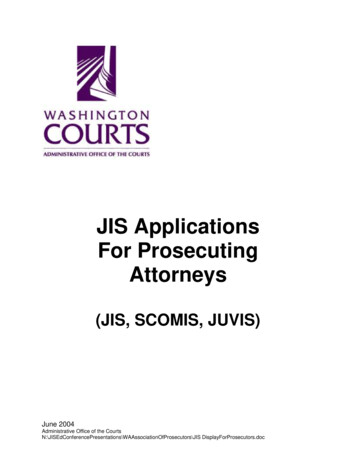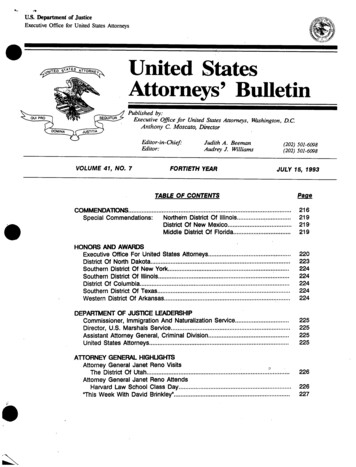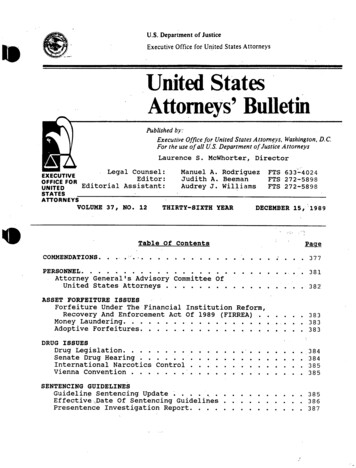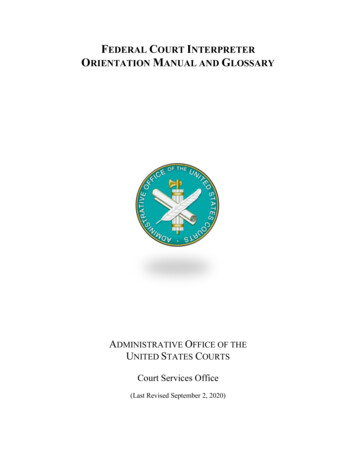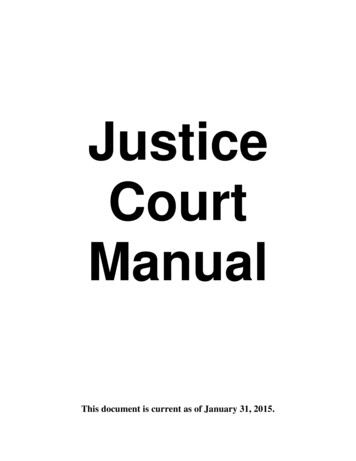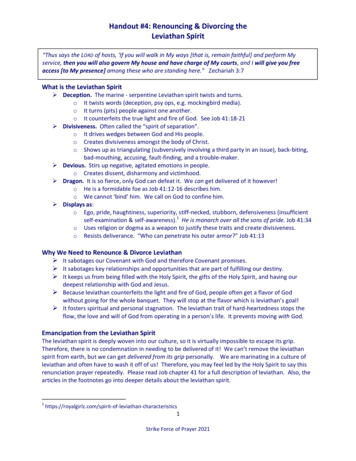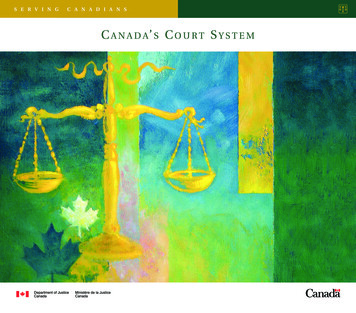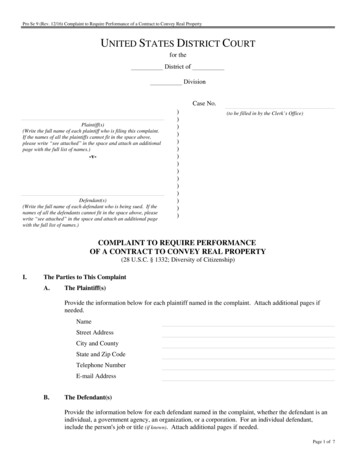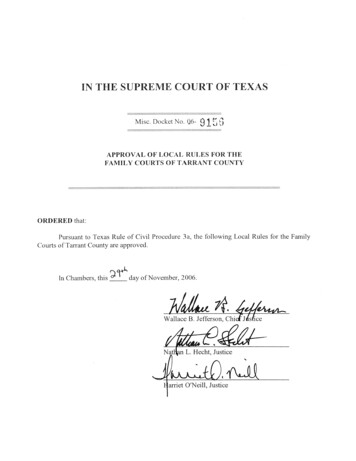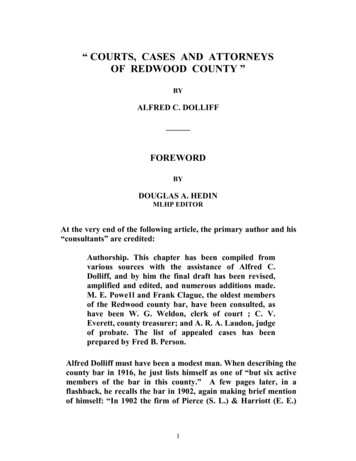
Transcription
“ COURTS, CASES AND ATTORNEYSOF REDWOOD COUNTY ”BYALFRED C. DOLLIFFFOREWORDBYDOUGLAS A. HEDINMLHP EDITORAt the very end of the following article, the primary author and his“consultants” are credited:Authorship. This chapter has been compiled fromvarious sources with the assistance of Alfred C.Dolliff, and by him the final draft has been revised,amplified and edited, and numerous additions made.M. E. Powe1l and Frank Clague, the oldest membersof the Redwood county bar, have been consulted, ashave been W. G. Weldon, clerk of court ; C. V.Everett, county treasurer; and A. R. A. Laudon, judgeof probate. The list of appealed cases has beenprepared by Fred B. Person.Alfred Dolliff must have been a modest man. When describing thecounty bar in 1916, he just lists himself as one of “but six activemembers of the bar in this county.” A few pages later, in aflashback, he recalls the bar in 1902, again making brief mentionof himself: “In 1902 the firm of Pierce (S. L.) & Harriott (E. E.)
appeared, as did the firm of Bowers (J. H.) & Howard (C. T.),while Frank Clague (county attorney, Lamberton), A. C. Dolliffand A. R. A. Laudon had been added to the Redwood Falls bar.”Dolliff’s style differs from that of most other lawyers who wrotechapters on the “bench and bar” in county histories published inpre@World War One in this state. Quite frequently lawyer@authorsdevoted several paragraphs to themselves, their families, theoffices they held in local government and in fraternalorganizations, and so on. If Dolliff was not listed in the “author@ship” paragraph of this article, the reader would not know that heprepared it —after “consultation” with several other lawyers, hewas careful to note.Alfred Dolliff was born on September 30, 1874, and died suddenlyin Redwood Falls on April 20, 1945, at the age of 70. His deathwas announced on the front page of, a placeof such prominence that a man of his modesty might have found ituncomfortable:A. C. Dolliff DiesHere Late FridayFuneral rites were held at 4 p.m. Sunday at thePresbyterian church here for Alfred C. Dolliff, whodied Friday at the Redwood Falls hospital from aconvulsion following uremic poisoning. He had beenin poor health for the past few weeks.The Rev. W. A. Dalton conducted the service andinterment was in the city cemetery.Mr. Dolliff had been at his law office during themorning, had gone to lunch and returned to his officeand at 1 p.m. was stricken. He was immediately takento the hospital where he died at 7 p.m.
Born September 30, 1874, at Oldtown, Maine, he wasthe son of Lucius P. and May Gould Dolliff. He wasreared in his native state and in Minnesota. Afterattending Carleton college for three years he enteredthe University of Minnesota, where he was a memberof Delta Chi fraternity. He was graduated from thelaw department June 7, 1895, was admitted to the barand a few months later, on September 4, 1895, hecame to Redwood Falls. He had been in activepractice of his profession in the nearly fifty yearssince then. In January 1945, Morris Kuhn ofMinneapolis became his partner.Known as one of Redwood county’s leading attorneys,he had also taken an active part in many of theactivities of the community. He had been city attorneyand as an officer in Co. 1, Minnesota National Guard.For many years he was an active member of theCommercial club and had always been a strongsupporter of the Masonic and Knights of Pythiaslodges and in the latter had occupied all of the chairs.He is survived by his wife, the former Lou Porter ofRedwood Falls and their son Roger, who is in theinsurance business in Minneapolis.The following article appeared first on pages 465 to 488 of thefirst volume of a two volume history of Redwood County. TheMLHP has reformatted the chapter, and added page breaks.Dolliff’s punctuation and spelling have not been changed.This article may be read in conjunction with “The Lawbreakersof Redwood County,” a chapter in Wayne E. Webb and J. I.Swedberg’s.459@490 (St. Paul:North Central Pub. Co., 1964). It is posted separately on theMLHP.
“COURTS, CASES AND ATTORNEYSOF REDWOOD COUNTY”INTHE HISTORYOFREDWOOD COUNTYMINNESOTACOMPILED BYFRANKLYN CURTISS@WEDGE.Member of the Minnesota Historical Society, Member of the National HistoricalSociety, Member of the Wisconsin Archaeological, Society; Editorof the Histories of Goodhue, Dakato, Rice, Steele,Mower, Freeborn, Fillmore, Winona, Wrightand Renville Counties, MinnesotaREVIEWED BYJULIUS A SCHMAHLSecretary of StateVOLUME ICHICAGOH. C. COOPER JR. & CO.1916
CHAPTER XXXIV.COURTS, CASES AND ATTORNEYS.On June 11, 1849, Alexander Ramsey, the first territorial governorof Minnesota, issued a proclamation dividing the territory intojudicial districts. The Third District consisted of all of the territorysouth of the Minnesota and west of the Mississippi, and westwardto the territorial line. The present Redwood county was included inthe Third District with Judge David Cooper on the bench. The firstterm of court for the district was to be held at Mendota, on thefourth Monday in August.Redwood county was at that time entirely without settlers.By act of the legislature, October 27, 1849, the entire territory wasdivided into counties. Wabashaw county, as designated under theact, was comprised of practically the entire southern [466] third ofthe present state of Minnesota, and the southwestern portion ofSouth Dakota, and thus included the present Redwood county.Itasca and Wabashaw (as it was then spelled) counties were, forjudicial purposes, attached to Washington county, with JudgeDavid Cooper on the bench.The legislature of 1851, by Chapter 1 of the Revised Statutes,passed January 1, reapportioned the territory into new counties.The present county of Redwood, under the new distribution, wasentirely embraced in Dakota county, which county was attached toRamsey county for judicial purposes.March 5, 1853, the present Redwood county was included in thecounty of Blue Earth, which county, by legislative act of that date,was endowed with all the rights of a fully organized county.February 20, 1855, Brown county was constituted a fully organizedcounty, and included within the boundaries the present Redwoodcounty.
At that time the Indian reservation had been established, butRedwood county had no settlers outside of the government em@ployees, the Indians, and the traders at the Lower Sioux Agency.Redwood county was created February 6, 1862, and its organi@zation affirmed February 23, 1865, the eastern, boundary on thelatter date being the same as at present, the western boundarybeing the state line.The county then became a part of the Sixth Judicial District, and soremained until March 11, 1870, on which date it became a part ofthe Ninth Judicial District, the district in which it still remains.Judge Horace Austin, of St. Peter, went on the bench of the SixthJudicial district, January 1, 1865. He had jurisdiction overRedwood county, but heard no Redwood county cases. He did,however, hold court in Redwood county to hear the so@called NewUlm cases.Judge M. G. Hanscome, of St. Peter, who had been on the bench ofthe Sixth district since October 1, 1869, went on the bench of theNinth district as its first judge, March 11, 1870. He presided overthe annual September terms of 1871, 1872, 1873, 1874 and 1875,and the annual June term of 1876 and 1877.Judge E. St. Julien Cox of St. Peter went on the bench of the Ninthdistrict in 1877. His first official act for Redwood county was anorder in chambers at St. Peter, May 23, 1878, dispensing with theservices of the grand jury for the forthcoming June term. One ofthe early acts of Judge Cox was his appointment, April 25, 1878, ofa commission consisting of Bishop Gordon, Till Tibbetts and M. K.Butterfield, to determine the value of lands and damages incident tothe building of the railroad from Sleepy Eye to Redwood Falls.During Judge Cox’s term the legal [467] business of the county wasgreatly increased. Two regular annual terms were inaugurated andseveral special terms were held. Judge Cox’s last service inRedwood county was in presiding over the special terms atRedwood Fails, October 21, 1881, and at about this time charges
were filed against him asking for his impeachment as judge, andthe legislature next convening in January, 1882, heard the chargesand he was impeached by it, the principal charge being that ofalleged misconduct while sitting on the bench and hearing cases.After his impeachment he again took up the private practice of lawat St. Peter, where he lived for about fifteen years thereafter, andsubsequently moved, to California where he since died.Judge William Lochren of the Fourth Judicial district, andafterwards United States district judge for the District of Minne@sota, having been appointed such by Grover Cleveland, thenpresident, presided over the term of December, 1881.Judge Hial D. Baldwin, of Redwood Falls, was appointed to thebench of the Ninth district by Governor Lucius F. Hubbard, April4, 1882. He held two general terms of court, those of June 6, 1882,and December 5, 1882.Judge Benjamin F. Webber, of New Ulm, was elected judge of theNinth Judicial district at the fall election of 1882, and assumed theoffice January 3, 1883, and first presided over a Redwood countyterm of court at Redwood Falls, convening June 5, 1883. Hecontinued as judge until October, 1906, when he resigned, thoughthis term would have expired December 31st following. The eventsfollowing his resignation were quite tragic; having served nearlytwenty@four years on the bench of this district and practicallywithout opposition, at the election in the fall of 1906 he again filedas a candidate. The opposition to his election was quite strong andhe thereupon withdrew as a candidate and resigned his office; and,after his successor had been appointed and immediately precedingthe convening of the fall term of court at New Ulm, his home town,he took his own life, and thus passed one of the oldest judges, bothin point of age and service, then upon the bench in the state.Judge Oscar Hallam of St. Paul, one of the judges of the SecondJudicial district, presided over the November, 1906, term, hehaving been appointed for that purpose by Governor John A.Johnson, pending the election of a successor to Judge Webber.
Judge I. M. Olsen of Sleepy Eye, the present judge, went on thebench of the Ninth Judicial district, by appointment of GovernorJohn A. Johnson, November 15, 1906, he having just been electedjudge of the district at the November election to succeed JudgeWebber, then resigned. Judge Olson’s first term in Redwoodcounty was that of April, 1907.The present officers of the court are W. G. Weldon, clerk; [468]Albert H. Enersen, county attorney; Frank J. Hassenstab, sheriff;and W. T. Eckstein, official reporter.The first term of the District Court held in Redwood county was forthe purpose of a grand jury inquiry into the New Ulm murdercases. The hearing was held above the store of Louis Robert,beginning June 18, 1867. Two soldiers, returning from a trappingexpedition, had entered a saloon at New Ulm, an altercation ensuedin which one of the merry@makers at the saloon was killed, the twosoldiers had been taken to a hall, a mob verdict passed againstthem, and after being killed by stabbing had been thrust throughthe ice of the Minnesota river, their bodies being mutilated in theprocess. There being no opportunity for a fair trial at New Ulm,Judge Austin ordered the hearings heard at Redwood Falls, whichwas likewise in his jurisdiction. Later a trial in the same cases washeld at St. Peter.The attorneys employed in the case at Redwood Falls were:William Colville, attorney general ; Sam McPhail, county attorney,and S. A. Buel, for the prosecution ; Judge C. E. Flandrau of St.Paul, C. T. Clothier, Francis Baasen and John M. Dorman all ofNew Ulm, for the defense. At the first hearing at Redwood Falls thecitizens of New Ulm rallied in such numbers to the support of theprisoners that courthouse square was covered with their tents asthey encamped during the hearing. They were present again at theadjourned hearing at Redwood Falls in September, but in smallnumbers.The first regular term of the District Court of Redwood countyopened in Redwood Falls, September 13, 1870, in a small building
on Second street, between Washington and Mill streets, JudgeHorace Austin on the bench. The grand jury found no indictments.The case of William Beard v. J. Wilson Paxton, appealed from thejustice court, came for consideration and the judgment of the lowercourt was affirmed. A divorce case was also on the calendar.A demurrer was filed in the case of Birney Flynn vs. the Board ofCounty Commissioners. This case, which was afterward dismissed,was an interesting one. Mr. Flynn was clerk of court from January1, 1866, to January 1, 1870. At that time no court was being heldfor Redwood county. Mr. Flynn, however, acted as clerk of thesessions held in Redwood Falls in June and September, 1867, atwhich the New Ulm cases were tried. For services at these twosessions, and for the alleged use of his office, he sued the countycommissioners, and the case hung fire for some time before it wasfinally dropped.The first jury trial before the district court in Redwood county washeld in September, 1871. The case is interesting as a picture ofpioneer life and law. Browning Nichols, of Rochester, on his way toa townsite in which he was interested in Lac qui Parle [469] county,stopped over night at Redwood Falls, and fell in with in with D. L.Bigham. With Mr. Bigham, he traded his pair of horses and aharness for land in the village of Redwood Falls, on which manyimportant business establishments are now located. Mr. Nicholssecured the deed to the lots and continued on his way with hishorses. One of the animals died on the trip. On his return, Mr.Nichols placed the remaining horse, the tail of the dead horse, andthe harness, in Mr. Bigham’s stable. On the advice of an attorney,Mr. Bigham turned the horse loose, and threw out the harness andtail. He then brought suit against Mr. Nichols. In the District courttrial, Mr. Bigham was represented by M. E. Powell and Hial D.Baldwin, while Sam McPhail and E. St. Julien Cox appeared forMr. Nichols The jurors in the case were W. W. Byington (foreman),S. J. F. Ruter, Ezra Post, George Pryor, Sr., L. J. Russell, L. B.Newton, James Longbottom, Bishop Gordon, S. M. Stowell, J. P.O’Hara, Casper Stowell and J. M. Little. The whole case hinged onwhether the horse had passed into Mr. Bigham’s possession at the
time of the transfer of the lots and before Mr. Nichols had taken thetrip. The evidence tended to show that the delivery of the horseswas not to take place until they were actually turned over to Mr.Bigham. After the trial the jury retired for deliberation to a smallbuilding near the room in which the court had met. Through thedoor and window their deliberations could plainly be seen by thespectators. While the deliberations were proceeding, the partiesconcerned reached an agreement by which Mr. Bigham was to berestored all his land except one lot, and he was to assist Mr. Nicholsin locating the horse, which in the meantime had wandered away.The court records show a sealed verdict in favor of the plaintiff anda notice of an appeal, but this is often called the case with noverdict, owing to the fact that a compromise had been reachedwhen the sealed verdict was opened.THE BAR.M. E. Powell, the Nestor of the bar in Redwood county, is not nowin active practice, but is still a member of the bar. The next oldestin point of service is former Senator Frank Clague, of RedwoodFalls. The other Redwood Falls lawyers are A. R. A. Laudon, thepresent judge of probate; and A. C. Dolliff. Albert H. Enersen, thecounty attorney practices at Lamberton as does Anthony J. Praxel.W. R. Werring practices at Morgan. A. F. Goblirsch has been untilrecently located at Wabasso. There are, therefore, but six activemembers of the bar in this county, and two of those are occupyingcounty offices.Sampson B. B. McPhail, usually called Sam McPhail, and some@times erroneously called Samuel McPhail, was the first lawyer in[470] Redwood county. He founded Redwood Fails in 1864. He wasthe first judge of probate and first county attorney, and continuedin active practice as long as he remained here.The second attorney in Redwood county was Major M. E. Powell,who arrived in April, 1867, and is still the Nestor of the Redwoodcounty bar. He was one of the early county attorneys.
Coulter Wiggins started the practice of law in Redwood Falls in1868. He succeeded Col. McPhail, both as judge of probate and ascounty attorney.W. H. Cook arrived in Redwood Falls in 1869, George H. I.Megquire in 1870, and Hial D. Baldwin in 1870. Mr. Megquirebecame a leading figure in Renville county affairs, while Mr.Baldwin served Redwood county as district judge, judge of probate,and clerk of court.J. Wilson Paxton, who arrived in the early days, was a lawyer aswell as clergyman, but his name appears in the district courtrecords as a case attorney but once.In 1878, the attorneys of Redwood Falls were Hial D. Baldwin,John H. Bowers, M. E. Powell and Alfred Wallin. In 1880, Frank L.Morrell had joined H. D. Baldwin of Redwood Falls and Samuel R.Miller of Beaver Falls, in the Redwood Falls concern of Baldwin,Miller & Morrell. In 1884 Clarence T. Ward had been added to thebar as a partner of H. D. Baldwin. In 1888 M. M. Madigan hadbecome a member of the Redwood Falls bar. M. C. Robertspracticed a few months in the eighties. In 1894, the firm of (H. D.)Baldwin, (W. J.) McLeod & (B. F.) Fowler, appeared. In 1894 W. L.Pierce had been added to bar. Two new firms, Baldwin (H D.) &Patterson (E. C.) and Chadderdon (Joseph) & Stuart (David),appeared. E. E. Harriott became a member of the bar in 1900. In1902 the firm of Pierce (S. L.) & Harriott (E. E.) appeared, as didthe firm of Bowers (J. H.) & Howard (C. T.), while Frank Clague(county attorney, Lamberton), A. C. Dolliff and A. R. A. Laudonhad been added to the Redwood Falls bar. The name of S. L. Piercewas added to the bar in 1904. In 1906 C. T. Howard started inpractice alone. Wm. O. Owens appeared in 1910.The first lawyer in Lamberton was Michael M. Madigan. In 1882George Libby and the firm of Thorp (D. M.) & Whitney (B. H.)were added to the practitioners there. After Madigan moved toRedwood Falls in the late eighties, several years passed in whichthere were no attorneys in Lamberton. In 1894 the firm of
Anderson (Christopher H.) & Clague (Frank) appeared. A. E.Edwards had joined the bar of the village in 1896 and in 1897moved to Morgan. In 1898 Frank Clague was still in practice there,and Warren Miller and A. H. Mohler had been added to the list. In1902 Albert H. Enersen had joined the bar of the county and heand Frank Clague constituted the only law firm [471] inLamberton, the firm name being Clague & Enersen. In 1910,Anthony J. Praxel had been added to the list. Senator Clague soonafterwards moved to Redwood Falls, leaving the Messrs. Enersenand Praxel as the only attorneys in that village.D. M. Thorp was the first lawyer in Walnut Grove. In 1882 he hadbeen succeeded by the firm of Thorp (D. M.), Quarton (J. M.) &Whitney (B. H.), which firm in 1884 had been succeeded by Thorp& Quarton. After that the village was without lawyers for severalyears. William H Gooler was located there in 1900. He remainedfor several years. In 1904 William G. Owens and J. Ed. Rostadwere the practicing attorneys there. In 1908 William G. Owens andArthur M. Murfin were the lawyers there. Since that time WalnutGrove has had no attorneys.The first lawyer in Morgan was Albert E Edwards, in 1896@97, andwas followed by Albert Hauser, who appeared in the directory of1900. He was followed by the present Morgan attorney, Wayne RWerring, whose name first appears in the directory of 1908.Pierce (Squire L.) & Harriott (Edw. E.) first appear in the Wabassodirectory of 1902. The name of Albert W. Mueller appeared m1904. The name of Albert F. Goblersch appeared in 1914. Mr.Goblersch recently left the county, leaving Wabasso without anattorney.F. E Sylvester, a banker, is an attorney, and until his recentremoval to Morton, in this state, where he is now engaged inbanking, was a member of the Redwood county bar at Seaforth, hisname first appearing in the directory in 1908.
Thomas B. Brownlee practiced in Sanborn a short time, his namefirst appearing in the directory of 1898.MURDERS.Edward McCormick, in the early seventies, was found dead at hishome, where he lived alone, and an autopsy revealed that he haddied from strychnine poisoning. His brother, Patrick, was held forseveral months, but was discharged for lack of evidence.Samuel P. Alexander shot and killed Charles Mower on the streetsof Redwood Falls July 21, 1885. He was subsequently tried by thedistrict court and acquitted. Mower lived in Missouri. His daughterwas the wife of Alexander. Leaving Alexander in Missouri, Mowerand his family started for Minnesota and had passed throughRedwood Falls on their way toward points further northwest. Ontheir return they located temporarily in Redwood Falls. With themwas a man named Petit. To Redwood Falls Alexander followed thefamily and on a July Sunday morning, when the streets were filledwith people accosted Petit and a Mower boy on the street andbegan shooting at them. Later encountering Mower at the corner ofMill and Chestnut streets [472] in front of the old Canada house, heemptied his revolver at him. Several shots taking effect and the lastshot, one through the head, proving fatal. The shooting waswitnessed by dozens of the county’s leading citizens who testified tothe cold blooded facts, but for some reason the jury brought in averdict of not guilty. Alexander himself acknowledged that he hadno grievance against Mower and that his only anger was againstPetit, of whom he was jealous and whom he alleged was planning tomarry his wife.John Gorres, a prominent farmer living in Willow Lake township,killed a hired man, John Rosenkranz, with a pitchfork, in thespring of 1888. The story was that he went home much the worsefor liquor, encountered Rosenkranz in the barn and there mur@dered him. He was tried before the district court, was sentenced tosix and a half years at Stillwater, and after serving for a while hewas parolled and eventually pardoned. He died in Willow Lake not
long ago. His life, after his release, was an exemplary one and hebecame a respected member of the community as, in fact, he hadalways been before the crime.Clifton Holden was indicted for murder November 28, 1888, wassentenced to death by hanging, had this commuted to lifeimprisonment by the government, went insane at state’s prison atStillwater and was taken to the insane asylum at Rochester andthere died. Before the governor granted his reprieve, the SupremeCourt had reviewed the case January 14, 1890, and had affirmedthe sentence of the lower court.The story of the crime is quickly told. At about 7 o’clock in theevening of Friday, November 23, 1888, the defendant and thedeceased, Frank Dodge, left the village of Morton, to drive in abuggy to the village of Redwood Falls, a distance of seven miles. Ata later hour of the same evening the defendant came, with the team,to a hotel in Redwood Falls, where he remained that night. At anearly hour the following morning the dead body of Dodge wasfound lying at the side of a street in Redwood Falls. He had beenshot, the ball having entered the head on the back side, and passedthrough the brain. Saturday evening, the 24th of November, thedefendant was arrested for the homicide, and imprisoned in a roomused for the purposes of a jail. Subsequently, Holden told twodifferent stories: One was that he had left Dodge in Redwood Fallsand had never again seen him alive. The other was that Dodgekilled himself while riding in a team with him and that hesubsequently left his body by the side of the road. The testimonywas voluminous but in substance showed as follows: That theweapon was discharged very close to the head of the deceased, thehair being burned about the wound; the discovery of appearancesof blood upon the defendant’s overcoat, which the defendant saidmust have got on the coat when he was [473] getting the body of thedeceased out of the buggy; the appearance of blood, also, in thebuggy, and on the robe used in the buggy; the fact that the deceasedprobably had a roll of money in bills, to the amount of about 100including a new 20 bill, and that, while immediately after thehomicide the defendant professed to have no more than about four
or five dollars in money, he had in his possession some 80 in bills,including a 20 bill; that after his arrest he attempted to concealthis money, so that the sheriff should not find it; that appearancesof blood were found on the money; that the defendant, according tohis own statement, threw away the pistol which he had before thehomicide, and it was not afterwards found; that the bullet was ofthe proper size to fit the defendant’s pistol. The overcoat and robeand money were exhibited to the jury as evidence, and attentionwas called to the marks claimed to have been blood@stains.The only hanging in Redwood county was that of William Rose,convicted in the district court for the murder of Moses Lufkin. Thehanging took place on the scaffold erected for that purpose in whatis now the alley back of the Christian Church in the city ofRedwood Falls. The victim, an elderly man, was assassinated in thetown of Gales, in the county of Redwood, at the house of hisrelative, the witness, Slover, who was well acquainted withdefendant, at about 8 o’clock in the evening of August 22, 1888. Hewas at the time seated on a lounge against the north window of theroom, conversing with Slover. The window was uncovered, exceptwith mosquito netting over the lower half, and the lower sash wasraised. His left shoulder rested against the window casing, leaving aportion of his back exposed to view from the outside. While, soengaged, he was suddenly shot, and immediately expired. The shotmust have been fired from the outside, and the direction of theweapon adjusted by the assassin with reference to the height of thewindow above the ground, and within a few feet of it. The ballpassed through the body of the deceased, and pieces of it werepicked up afterwards in the room. Slover, who sat nine feet away,immediately “jumped” to the window, looked out, and testified thathe saw a person fleeing in an opposite direction, about thirty feetaway, whom he recognized to be the defendant, William Rose, whowas well known to him, though he did not have a view of his face.Rose was duly indicted by the grand jury, was tried three timesbefore the district court, the jury in each of the first two trialsdisagreeing, and on the third trial he was found guilty, was sen@tenced to be hanged, and the sentence affirmed by the supremecourt, July 28, 1891.
John O’Connell was murdered at his home in Westline August 2,1897. While suspicion was strongly directed, there was no evidenceupon which an indictment could be secured. [474]Gustav Metag killed Frederick Kuehn in Sherman township in thefail of 1897. He was convicted and sent to Stillwater for life. Anumber of influential citizens interested themselves in his behalfand he has recently been released. Kuehn had disposed of his farmto a man who leased it to Metag, but was still living in a shack onthe place. Kuehn interferred with Metag’s farming in various ways.At last, after a vigorous dispute over a question of grain threshing,Metag, in a heat of passion, ended Kuehn’s life by shooting.Metag’s sentence was subsequently commuted by the board ofpardons, and he was thereafter released from the prison on paroleby the board of paroles.October 25, 1899, Frank E. Babcock, a well@to@do farmer living amile and a half west of Redwood Falls, killed his wife and threeboys, aged five, eight and fourteen years. He first shot his wife inthe barn, then wrote a note saying that he had intended to shoot arooster and killed her by mistake. Then he went out and shot thetwo younger boys where they were playing in the yard. The olderboy was at work in a field about a half mile distant, and he nextwent out to him, bade him unhitch the horses from the plow,stepped back some distance and shot him, and then immediatelyended his own life.Willis Tibbetts, on September 2, 1909, killed his daughter, Dorothy,and a young lady, Cecil Morton, in Delhi township and then endedhis own life.Ira B. Pratt died November 16, 1910. It was alleged that his deathwas hastened by blows received at North Redwood. Virgil L.Mallett was arrested in connection with the death, charged withmurder in the first degree and with manslaughter. He was tried inthe district court, was convicted of assault and sentenced to sixmonths in jail.
The Seaforth arson cases are still occupying wide attention inRedwood county. Thomas H. Jordan and M. E. Garvey, twoenergetic young land men from Iowa, acquired the hotel at Seaforthand hired J. W. Keyes to operate it. This hotel, which was the finestin the county, was burned to the ground on Easter morning, 1915.A number of the occupants narrowly escaped with their lives.Previous to the fire, the owners had increased the insurance andmade what was afterwards proved to be a bogus sale of theproperty to Keyes. The insurance companies and the state firemarshal at once began to investigate. Keyes, who was found by thefire marshal in Iowa, confessed that he set the fire at the instigationof Jordan and Garvey. He was taken to Minneapolis, where, withthe fire marshal, stenographers listening on the wire, he called upJordan and demanded money. Jordan, making some damagingadmissions, sent him a check for 100 by his brother. A photographof this check was afterwards introduced as evidence. Keyes wastried in the fall of 1915, [475] pleaded guilty
insurance business in Minneapolis. The following article appeared first on pages 465 to 488 of the first volume of a two volume history of Redwood County. The MLHP has reformatted the chapter, and added page breaks. Dolliff's punctuation and spelling have not been changed. This article may be read in conjunction with "The Lawbreakers
